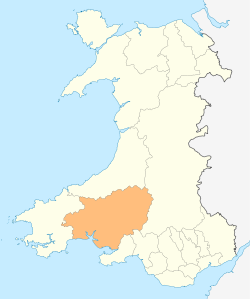Dre-fach Felindre
| Dre-fach Felindre | |
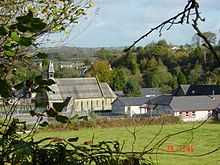 Overlooking Dre-fach Felindre |
|
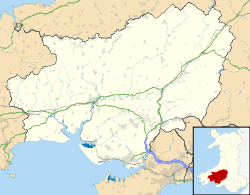 Dre-fach Felindre |
|
| Population | 1,200 (2001) |
|---|---|
| OS grid reference | SN354385 |
| Community | Llangeler |
| Principal area | Carmarthenshire |
| Ceremonial county | Dyfed |
| Country | Wales |
| Sovereign state | United Kingdom |
| Post town | LLANDYSUL |
| Postcode district | SA44 |
| Dialling code | 01559 |
| Police | Dyfed-Powys |
| Fire | Mid and West Wales |
| Ambulance | Welsh |
| EU Parliament | Wales |
| UK Parliament | Carmarthen East and Dinefwr |
| Welsh Assembly | Carmarthen East and Dinefwr |
|
|
Coordinates: 52°01′16″N 4°24′00″W / 52.021°N 4.400°W
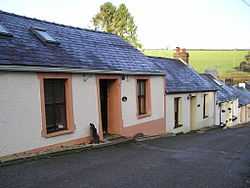
Dre-fach Felindre is a village in Carmarthenshire, West Wales. It is located four miles south-east of Newcastle Emlyn. It lies at the confluence of three fast-flowing streams, the Nant Bargod, Nant Esgair and Nant Brân, where their steep-sided valleys open out into the Teifi Valley. In the 19th and early 20th century it was an important centre for the woollen industry and was given the epithet, "the Huddersfield of Wales". As the population increased, the villages of Dre-fach (Welsh language, small town) and Velindre (Welsh language, mill town) extended and merged to form the present community.
The Museum of the Welsh Woollen Industry, now the National Woollen Museum, was opened in 1976 in the Cambrian Mill.
History
Little development happened in this area before the late 18th century and it is not clear why Dre-fach Felindre became such an important centre for the production of woollen cloth in Wales. By the early 19th century, four fulling mills were established at Pentrecwrt, Dolwyon, Drefach and Cwmpencraig. Spinning and weaving were done by hand or in small workshops at this time. In the 1850s, the power loom was introduced, the need for water power increased and there was a great expansion of the industry. Substantial mills, some employing 50-100 people, were built at Drefach, Felindre, Drefelin, Cwmpengraig, Cwmhiraeth and Pentre-cwrt by the first decade of the 20th century. The population increased in Drefach and Felindre and houses were built for mill workers and mill owners, shops opened and St Barnabas' Church and other places of worship were built. Overflow settlements occurred at Cwmpencraig and Cwmhiraeth, where more factories, mill owner houses, worker houses and chapels clustered in the narrow valleys. The woollen industry declined from the 1920s onwards and the mills closed one by one.[1]
At its peak, there were ten mills on Nant Bargod and twenty four in the whole village.[2] As the textile industry flourished, so did the social, cultural and religious institutions in the village. Because Dre-fach Felindre was reliant on industry rather than on agriculture like the surrounding countryside, the outlook of the inhabitants was different. It resembled that of the South Wales valleys with their billiard halls, brass bands, male voice choirs and football teams.[3]
Culture and community
Dre-fach Felindre has little industry today. The mills still stand as monuments to the past but have been put to other uses. One now houses the National Woollen Museum, another a furniture warehouse and others have been converted to residences or accommodation for holiday visitors. There is a post office, a few shops, a church, several chapels and a primary school, Ysgol Gynradd Penboyr. There is a community hall, the Red Dragon Hall, and a children's playground. The football club, Bargod Rangers, plays at the community park, Parc Puw.
The poet and broadcaster Aneirin Talfan Davies was born in the village.
Religious sites
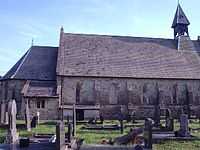
A small chapel-of-ease to Penboyr parish had been founded by the early 18th century, within what was to become Felindre. By 1750 Holy Trinity Chapel, also known as Capel Bach, which was possibly a post-medieval foundation, had become "dilapidated". It was eventually replaced by St Barnabas' Church in 1862.[4]
St Barnabas' Church was built for Lord Cawdor (whose birthday was St Barnabas' Day - 11 June), as was the church of St Barnabas' at Rhandirmwyn. The church lies within a triangular churchyard. On its north-east side it is bounded by the B4333 road which runs through the village. The church is of Gothic style and is constructed of Pwntan sandstone with yellow ashlar dressings. It consists of nave, chancel with polygonal apse (which is shafted), south porch and open timber west bellecote.
Inside the church high thin trusses are supported by corbels. The church has a pipe organ and a number of stained glass windows, Three of the apse windows, which date from 1863, are by Heaton, Butler and Bayne and are considered among the best of this period in the region. Near the entrance is a tile depicting the coat of arms of Lord Cawdor.[5]
The Unitarian chapel of Penrhiw was converted from a barn in 1777.[4] In 1952 it was dismantled stone by stone and rebuilt at St Fagans National History Museum in 1956.[6] The original chapel had a loft, which was removed in the 19th century. The present gallery was added, increasing the seating capacity considerably. The floor of the building was of beaten earth except for the communion area which was boarded. Outside are stone seats, which would have been used during preaching festivals.[7] Services are still held in the chapel at its new location, and burials still take place at the cemetery at its original site on a grassy slope overlooking Felindre.[8]
Bethel Baptist Chapel is situated in Drefach[9]
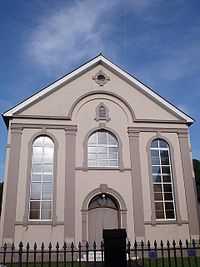
References
- ↑ Archaeology in Wales.
- ↑ The Woollen Mills of Wales, leaflet from National Museum Wales.
- ↑ Jenkins, J. Geraint. Ceredigion: Interpreting an Ancient County. Gwasg Careg Gwalch (2005) pg. 12.
- ↑ 4.0 4.1 "DREFACH - FELINDRE: Historic Background". cadw. Retrieved 23 January 2013.
- ↑ N.Vousden (22 November 2012). "ST BARNABAS' CHURCH, FELINDRE". RCAHMW. Retrieved 23 January 2013.
- ↑ Gareth Hicks (31 January 2006). "St Fagans - Chapels database". genuki.org. Retrieved 23 January 2013.
- ↑ "Pen-rhiw chapel interior, Museum of Welsh Life at Gathering the Jewels". Culturenet Cymru, The National Library of Wales. Retrieved 23 January 2013.
- ↑ Jones, Alun L. (editor), A Century of Photographs. (2000) pg. 76.
- ↑ Bethel Baptist Chapel at geograph.org.uk
| ||||||||||||||||||||||||||
